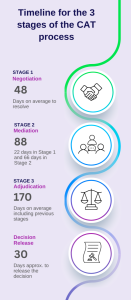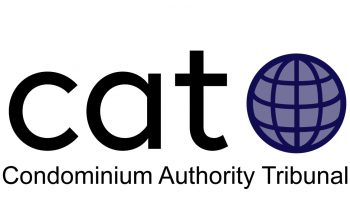 April 2023
April 2023
The Condominium Authority of Ontario (CAO) is celebrating its fifth year of operation. In this five-part series, Toronto Condo News looks at how CAO and the Condominium Authority Tribunal have impacted on condominium living and management, and present an inside-view of what it is like to appear before the Tribunal.
February 2022 – Fairness and Justice in Condominium Communities
March 2022 – What they Don’t Want you to Know – Lurking behind their closed door
April 2022 – Making a Successful CAT Submission
May 2022 – Calling for the Expansion of CAT
June 2022 – Condo Disputes without CAT
The Condominium Authority Tribunal (CAT or Tribunal) is an online dispute resolution system intended to help resolve certain types of condominium-related disputes. The Condominium Authority of Ontario (CAO) is to be commended on creating a process to address condominium-related disputes without resorting to the court system. The process and system they have established balances the interests of opposing parties in an economical manner.
The system, intended to be accessible to anyone with a legitimate issue, can be intimidating, challenging and time-consuming. It is not easy nor, perhaps, should it be.
 When presenting a dispute before the Tribunal it can be helpful to understand the process, what is required and tips from those who have already been to the CAT. Toronto Condo News monitored one CAT submission to its final Tribunal Decision. We offer our insights along with tips and suggestions (bullet points within this article) to improve your likelihood of success.
When presenting a dispute before the Tribunal it can be helpful to understand the process, what is required and tips from those who have already been to the CAT. Toronto Condo News monitored one CAT submission to its final Tribunal Decision. We offer our insights along with tips and suggestions (bullet points within this article) to improve your likelihood of success.
The system generally presumes that both parties in a dispute are honest, sincere and seek a reasonable resolution. When this is not the case, it helps to understand the process and how to proceed.
Maintaining Records
Long before submitting a matter to the Tribunal, there should be a paper trail of documentation supporting your position. While it can be more convenient and productive to deal personally with people, there is a need for all matters to be documented. Should there be a future dispute in how a matter was handled or addressed, this documentation is necessary. Without supporting documentation, anyone can deny a conversation or event took place. It is always advisable for condo residents and management to prepare and provide documentation to the other party, even after a matter may have been addressed verbally, and retain a copy for their records. Condo directors should ensure all decisions, votes and funding matters are documented in meeting minutes.
Balance of Power
Most matters before the Tribunal involve an owner, or resident, against their condominium corporation. While there are legitimate reasons for one party to utilize a lawyer, this creates an inherent unfairness.
It is more likely that a condominium corporation will chose to employ a lawyer as their representative. They can more easily do so by using corporation funds to support actions that may be proper or improper. As keeper of records, they alone are aware of what specific records exist and actually available for production.
A lawyer’s job is only to defend their client
Robert Rotenberg
Criminal Lawyer/Author
The lawyer has one job and that is to defend their client. Their client can be correct in their position, failing to comply with the Condo Act, or acting illegally. The lawyer’s job is to obtain the best possible outcome for their client.
This provides condominium corporations with a considerable advantage over an owner representing themself. Where the condominium corporation wants to avoid producing documents or hide their own misdeeds, using a lawyer as their representative can be advantageous. They can use corporation funds to defend or misrepresent improper or even illegal actions.
The condominium corporation has greater financial risk when they choose to use legal counsel
The CAT does an admirable job of restoring balance by imposing a maximum cost of $200 and a reluctance to pass along legal costs incurred by either side. The condominium corporation has greater financial risk when they choose to use legal counsel.
- The system is designed so that both parties can proceed without using a lawyer. Yet even Tribunal members may advise an individual to consider use of legal counsel.
Before Submitting to the Tribunal
The Tribunal does not deal with what someone may feel or believe. Their focus is on compliance with the Condo Act and governing documents of the corporation. Before submitting to the Tribunal, ensure your position is supported by available documentation. Those relying on belief or faith are likely to be disappointed.
Understand what the Condo Act or your governing documents say about the matter you intend to present to the Tribunal
Understand what the Condo Act or your governing documents say about the matter you intend to present to the Tribunal.
Consider your communication skills. The Tribunal primarily operates through written online communications, document submissions and some virtual meetings or hearings. In written communications it is helpful to be articulate, concise, organized and clear. For virtual hearings, be comfortable with presenting in front of a Tribunal Member and whoever is representing the opposing side.
Initial Submission

The Applicant begins by making a written submission explaining their reason(s) for going before the Tribunal.
- Submissions have a character limit. It is advisable to prepare submissions in your word processing application, then copy it to the online system. This avoids an incomplete or partial submission to inadvertently be posted.
The Tribunal must accept a submission before it is allowed to proceed. Once accepted, your submission will be heard or reviewed by the Tribunal. This occurs in three stages over a period that can be eight weeks or more.
Stage 1 – Negotiation
Both parties are encouraged to resolve the matter between themselves through written communication using the online dispute resolution system. Resolution at this stage, without involving a Tribunal Member, is the fastest and easiest solution. The matter remains private and confidential when resolved at this stage.
Resolution is only likely to occur when both parties are sincere in the effort. Frequently, this is not the case.
- Should neither party choose to participate in Negotiation for 30 days, the application is automatically closed UNLESS one party formally proceeds to Stage 2.
Stage 2 – Mediation
A CAT Mediator joins the case and attempts to help the parties come to a resolution. If resolution is not possible, the Tribunal Member will attempt to clarify and possibly narrow the issues that are to be addressed.
- This stage includes an area for submitting documents using the online system. Some may choose to submit documents to support their case. This is premature since evidence does not yet appear to play a role in the proceedings. It can be prudent to avoid submitting documents unless specifically requested to do so or they are pertinent to what is currently being addressed. Premature disclosure of documents can be helpful to opposing parties in the dispute.
- A CAT Member may request information from both parties and provide a response deadline. It is advisable to provide the required response prior and as close to the response deadline as possible. This prevents opposing parties in the dispute from having time to read your response and modify their submission.
- A settlement agreement between the parties resolves the issues in dispute and closes the case. Contents of a settlement agreement are not available to the public. This can include issues of relevance to both parties even if beyond the authority of CAT, and occurs after all parties agree to a settlement offer. Should one party fail to abide by a settlement agreement, the other party can file another case with the Tribunal seeking a compliance order.
- A consent order is one that CAT makes with the agreement of all of the Parties. This typically resolves all issues in a dispute and will close the case. A Consent Order is a public document which can only include matters over which CAT has legal authority. Should one party fail to abide by the Consent Order, the other party can seek enforcement through the courts.
Since the CAT Mediator is attempting to obtain resolution, they are unlikely to review “evidence” placing either party in the wrong. They may not choose to inquire about statements or positions presented by one side that appear questionable. Mediation is about compromise.
- Information and communication during this stage remain confidential and cannot be used in Stage 3.
Should resolution not be possible, the applicant can move the case to Stage 3 – Tribunal Decision after receiving permission from the mediator.
- The Applicant has 15 days to move the case forward. If the case does not move forward, it is closed. Documents and messages shared Stage 1 – Negotiation and/or Stage 2 – Mediation remain private and confidential. Neither party can share or tell others about messages or documents received from others during these stages without permission of the other party unless required by law to a government organization or a court.
Stage 3 – Tribunal Decision
A CAT Member joins the case. Parties are provided the opportunity to present their case. This includes sending messages, uploading documents or other evidence, and calling witnesses. The CAT Member considers the evidence and arguments submitted, and makes a final order. This closes the case. The final order is binding.
- Submissions during Stage 2 are not relevant during Stage 3. Either party may take a position that differs from what was stated on official CAO forms or earlier in the proceedings.
It is said that a good court, arbitration or mediation decision is one where neither party is satisfied. The Tribunal appears to have taken this to heart.
It is rare for a decision to award legal costs to either party. A condo board choosing to spend tens of thousands of dollars defending a position can be the loser even if they are successful. It can be smarter to resolve a dispute before significant legal fees are incurred.
The CAO Tribunal seems focused on the many personal interactions between condo boards and residents. They appear less inclined to address larger issues that can offer lasting improvements in condominium living, management and governance. One consequence of this is that a Tribunal Decision may have a different focus than what was addressed which is not evident from their published decision. The Tribunal can choose to focus on only those issues they choose to decide on. They can interpret submissions differently than submitted, ignore submitted information or remain silent on specific matters at their discretion.
- The final order provided by CAT is a public record. This can include any messages, documents or other material posted to the CAT system.
We look forward to a time when the CAO and CAT will address more significant best practices pertaining to reserve fund funding, fair and transparent condo elections, misuse of proxies, retention of electronic records and other matters that are more impactful.
Condominium Authority of Ontario provides the following documents to aid in filing with the Tribunal:
This article was prepared while monitoring a Tribunal submission by one condo resident seeking access to corporation records. The entire process from requesting documents to receiving a Tribunal Decision took more than seven months.







